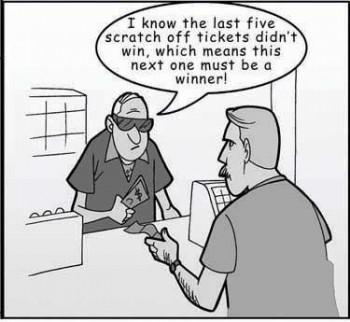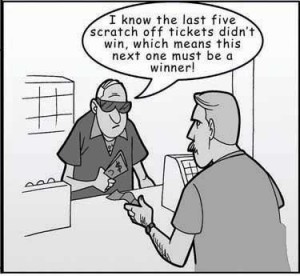The following is an excerpt from the quarterly letter we recently sent to clients on the lure of investment prediction.
Rock-paper-scissors ranks somewhere near the top of a list of universally known childhood games. The game separates itself from games of pure chance like coin flipping or the card game war in that participants can gain an advantage by recognizing non-random behavior patterns of an opponent. Even adults compete in rock-paper-scissors leagues and tournaments, seeking to out-predict their opponents. Successful participants recognize patterns to determine how the opponent is likely to follow a winning paper throw or a losing rock throw.
Such predictive forecasting, a trait which separates humans from other species, serves us well in life beyond a simple game of rock-paper-scissors. The use of nitrogen to expand agricultural yields or antibiotics to cure illnesses initially resulted from the same kind of advanced pattern recognition.
As a species, we have a demonstrated behavioral aversion to ambiguity and need for control. Resultantly, it is in our nature to look for patterns in rock-paper-scissors or other aspects of life. We make predictions about the future based on pattern recognition, celebrating the successes as a result of skill while attributing mistakes to bad fortune. A good investment is the result of intelligence and preparation whereas a bad investment is the fault of extraneous events. Our ill-conceived perception of successful pattern recognition reinforces an already inherent overconfidence bias.
To demonstrate our bias to look for patterns, an interesting experiment was done during the 1970’s which pitted the predictive ability of Yale undergraduates against a rat. The rat was placed in a T-shaped maze with food placed on either the left or right side for each trial. The sequence, unbeknownst to the students or rat, was random but arranged so that the food would be on the left side 60% of the time and 40% of the time on the right side.
The rat eventually learned that the food was more often on the left side and nearly always chose that direction. As a result, the rat was successfully rewarded with food 60% of the time. The students were asked to predict the side in which the food would appear. In keeping with a natural aversion to ambiguity, they looked for subtle patterns in the food placement and predicted the correct side just 52% of the time. Insistence on finding a pattern such as an alternating two left – one right sequence meant that the students were far less successful at prediction than the rat.
If the idea of being worse at prediction than a rat is discouraging, then perhaps it may be uplifting to learn that even the highly educated “experts” on TV and radio who are paid for their perceived expertise are no better at predicting the future than you, me, or the rat in this experiment.
Renowned behavioral psychologist Phillip Tetlock spent nearly 20 years examining the forecasting ability of experts and wrote an excellent book titled “Expert Political Judgment” on the findings. His study of 284 people who made a living “commenting or offering advice on political and economic trends” may be the most expansive study of expert predictions ever conducted. These experts made predictions about the future on questions like would George Bush be re-elected, would the dot-com bubble burst, and whether GDP growth exceed a certain level. By the end of the expansive study, Tetlock reviewed 82,361 forecasts.
The results are fascinating. They prove that we are better off relying on random guesses for forecasts of the future than on economic or political experts who write books, appear on TV and talk radio, and get paid to provide predictions. Tetlock says, “Even the most astute observers will fail to outperform random prediction generators – the functional equivalent of dart-throwing chimps.” Notably, Tetlock’s findings are no different than more than a hundred other studies that have compared expert predictions to simple statistical formulas. Humans, expert or otherwise, are just bad at making predictions.
The Impact of Lousy Forecasting
Once we come to the admission that not just the local weatherman but all 7.1 billion of us are poor at prediction, what comes next? There are two simple, powerful, and behaviorally difficult consequences for successful investing.
1) Ignore The “Experts”. Tetlock scrubs the data in his 20 years of research to look for any useful indicator of expert predictive success. Interestingly, the data demonstrates that education, expertise, or even knowledge of confidential information are not useful determinants of forecasting success. In fact, the more confident a forecaster is about the future, the greater depth of the expert’s knowledge (beyond a certain point), or the more famous the expert is, the less likely the predictions from such experts are accurate.
There are several explanations to help understand why forecasters are so poor at their job of forecasting and why the public continues to value their advice, despite the inaccuracy of forecasting. First, we are all inherently biased to overweight the likelihood of low-probability events. Robust behavioral research demonstrates that human brains have trouble comprehending probabilities and forecasters are no different. Second, we are seduced by elaborate stories more than by simple probabilities so forecasters give us what we want. Third, forecasters become successful not by hitting singles but by hitting home runs – making the prediction that no one else saw coming.
As a result, the most prominent forecasters are not successful because their predictions are accurate but because they create elaborate, well-reasoned, and unique predictions that differ from the mainstream. Incumbents win over 85% of Congressional elections and the US stock market produces a positive return in 87% of all 5-year periods. But forecasters do not make a name for themselves by simply predicting that such high-probability events are likely to persist, even though that extensional probabilistic reasoning is likely to be accurate. They instead become famous by creating imaginable narratives to explain why incumbents are likely to be defeated or the stock market is likely to fall over the next five years. Quite simply, they swing harder for forecasting home runs.
When occasionally correct, “forecasters are skilled at concocting elaborate stories about why fortune favored their point of view.” When wrong, they succumb to the hindsight bias – systematic misremembering of past predictions and claiming they knew more about the course of history than they actually knew.
There is no shortage of free expert opinion on the direction of interest rates, oil prices, the dollar, or stock prices. Yet most advice is free for a reason. We would all be well served to rely on historic evidence and probability rather than a forecaster’s plausible story about why the dollar is likely to appreciate or interest rates to rise.
2) Ignore Our Instincts. It is easier to look at experts in any field and criticize their mistakes or poor success as forecasters than it is to look in the mirror and admit our own predictive failure. The reality is that we’re all lousy at prediction, even if we have convinced ourselves otherwise. Our inherent behavioral biases cause us to make bad decisions and to look for meaning when there is none. According to Tetlock, “human performance suffers because we are, deep down, deterministic thinkers with an aversion to probabilistic strategies that accept the inevitability of error. We insist on looking for order in random sequences.” Furthermore, we hate to be wrong.
This inclination to refuse an explanation of chance and to seek patterns in random phenomena is expensive for investors. Rather than admit the future is unknowable, we are inherently tempted to look for patterns. Many investors continue to chase returns, jumping in and out of the stock and bond markets despite robust evidence to indicate the high cost of this futile exercise.
Saving Ourselves from Ourselves
Picking trendy investments and forecasting market swings is compelling to our behavioral biases. As with a simple game of rock-paper-scissors, we believe that we can seek out patterns and use the patterns to predict the future. It puts us in control and that is far more appealing than an admission of the alternative.
As we have noted before, we believe that there are three types of investors:
- those that know they don’t know the future direction of financial markets;
- those that don’t know that they don’t know; and
- those that know that they don’t know but get paid to pretend they do.
We are admittedly in the first category of investors. As a result, our investment discipline ignores market forecasts of our own or others. We do not seek out the next great star fund manager. We dispose of our pride and recognize that human tendency is to behave badly as investors. We ignore our hunches, ignore the “experts”, and rely on long-term disciplined investing, adding incremental value through less glamorous value-added steps such as diversification, asset location, factor-tilting, and cost-managed rebalancing.
Fortunately for you, much of the investment advisory industry consists of the other two categories of investors. This means that behavioral inefficiencies continue to exist which we seek to exploit by favoring cheaper investments and profitting as wealth transfers from the impatient to the patient.






Leave A Comment